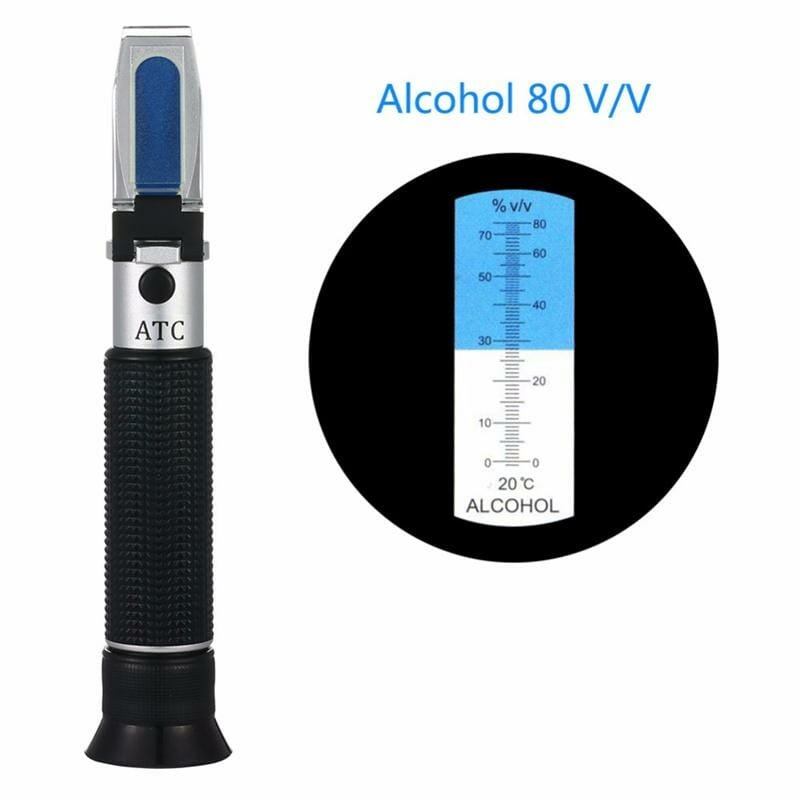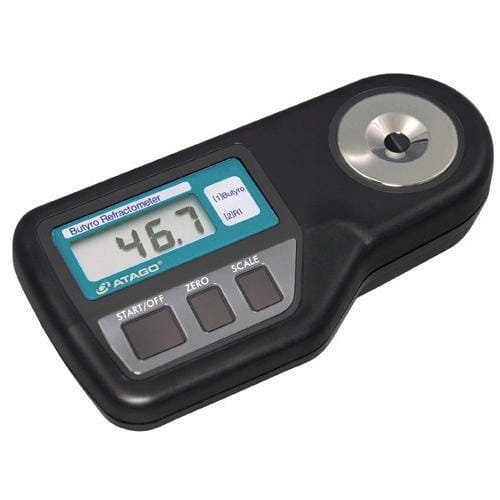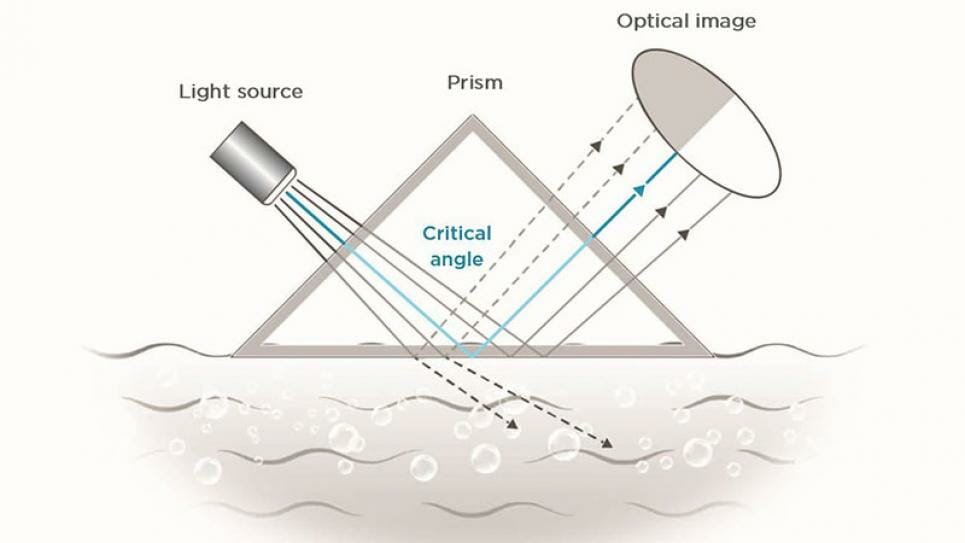
What is a refractometer?
A traditional handheld refractometer with a daylight plate
Regarded as a revolutionary device put into use in several industries, a refractometer is a device capable of measuring the concentration of soluble substances in the liquids like water/oil under consideration. With a few drops of the solution, you can produce the most accurate reading directly from the production line.
How does a refractometer work?

A schematic representation of how a refractometer work
Since a refractometer is used to measure the concentration of the aqueous solutions, it’s crucial to understand how the device operates and what is its working principle. As its name reads out, a refractometer uses the principle of refraction of light through different liquids based on their refractive index.
To start with, when a ray of light moves from one medium to another (rarer to denser or denser to rarer), the light ray tends to bend either away from the normal or towards the normal taking cognizance of their refractive indices. And the angle that forms between the normal ray and the output (refracted) ray is called the angle of refraction which is of prime importance to such devices.
As denser liquids contain higher amounts of dissolved solids, the speed of light is minimal in such liquids and thus, there is a more pronounced bending effect observed in the light. To put it simply, a typical refractometer uses a ray of light that passes through the liquid’s sample and displays its angle of refraction on the scale.
Most refractometers available in the market utilize a scale called the Brix scale for the measurements. It’s defined as the number of grams of 100% pure cane sugar (sucrose) thawed in 100g of pure water. Hence, a refractometer is also called a Brix refractometer. It’s mainly used in the food and beverage industry.
What is Brix?
Brix scale based refractometer
A Brix scale is a special scale originally developed to determine the concentration of sucrose (pure cane sugar) in a water solution. It was derived from the refractive index of an aqueous solution at 20-degrees Celsius. A Brix scale has been used since the 19th century and is the idea behind the other scales being currently used in industries like a locomotive, pharmaceutical, food, beverage, etc.
Influence of wavelength in refractometer readings
In refractometry, wavelength plays a critical role in determining the refractive index of the material. For instance, an increase in the wavelength of light results in a decrease in the refractive index of the material and thus affects the readings and vice versa. As a typical refractometer utilizes a glass prism, the absorption is very minimal to be precise. Hence, fluctuations in the refractive index appear on the glass prism that affect the final readings. To eradicate this and ensure a high-quality and accurate reading of up to 0.00002 in the refractive index, the wavelength needs to be chosen correctly. Hence, you will find the wavelength tuned to +/-0.2 nm in today’s models to ensure correct results for different solutions having different dispersion rates.
Influence of temperature in refractometer readings
Similar to the wavelength of the ray of light, temperature is also a critical factor that determines the refractive index of the liquid and thus its concentration. It’s to be noted that the temperature of both, the glass prism and the liquid under consideration is critical. This is because most people contemplate the temperature of the liquid as more important than that of the prism. There are multiple ways to achieve this but the most accurate ones being used are the temperature sensors and Peltier devices. These devices ensure that the temperature changes are such that they don’t influence the device readings to a great extent.
Types of refractometers
There are mainly four types of refractometers which are:
● Traditional handheld refractometers
● Digital handheld refractometers
● Laboratory or Abbe refractometers
● Inline process refractometers
Let’s discuss each of them below.
1. Traditional handheld refractometers

A traditional handheld refractometer
It’s also called the analog refractometer. In analog refractometers, the critical angle principle is used by which the prism displays a thin shadow line over a glass reticle. Since the marking is so small, you will have to magnify it to view it perfectly. To use a traditional handheld refractometer, place a few drops of the sample liquid onto the glass prism and cover them with a glass cover plate.
The device will then pass light through the sample that will either pass through the reticle or suffer total internal reflection (TIR). As a result, a thin shadow line develops between the illuminated area and the dark area. And here you can take the reading with the help of a magnifying glass. As said above, any temperature change can alter the readings of the refractive index, it’s suggested to use an automatic temperature compensation with the refractometer which is achieved by using a bi-metallic strip that will move the lens/prism according to the temperature changes.
2. Digital handheld refractometers

A digital handheld refractometer
A digital handheld refractometer also operates on the critical angle principle as in the traditional refractometer with the only difference being the use of an LED light source focused on the prism. When a few drops of the measuring liquid is placed on the prism’s surface and the light is applied through it, some amount of light is lost and the remaining light is reflected on the photodiodes creating a shadow line. And this position of the shadow line is directly related to the liquid’s refractive index.
Once the position of the shadow line gets fixed, the device’s internal software will get onto its work of determining the refractive index and will display the final result on the refractometer’s LED or LCD screen.
Due to the use of photodiodes, digital handheld refractometers are more precise in measurements than the traditional ones. However, you will need more quantity of sample with a digital refractometer as the sample isn’t evenly spread over the prism surface.
A digital refractometer may or may not be water-resistant and features a built-in automatic temperature compensation, unlike the traditional ones to control and check the temperatures of the glass prism and testing liquid.
3. Laboratory or Abbe refractometers

An Abbe or laboratory refractometer
A laboratory or Abbe refractometer is also known by the name benchtop refractometer. Such a device is more accurate and precise than digital refractometers. It got its name from its founder, Ernst Abbe (1840–1905). In an Abbe refractometer, the liquid sample is sandwiched between the refracting prism and illuminating prism. The refracting prism is made from glass having a high refractive index (say, 1.75) and thus, an Abbe refractometer can only be used for sample liquids with a refractive index lower than that of the prism.
To use an Abbe refractometer, a ray of light is passed through the illuminating prism and it’s detected by the built-in detector placed at the backside of the refracted prism.
Unlike the traditional and digital handheld refractometers, an Abbe refractometer is also suitable for measuring the refractive indices of solids like glass, plastic, polymer, etc. To assist you to obtain the readings without much hassle, the Abbe refractometers are equipped with LED or LCD screens.
4. Inline process refractometers

A schematic diagram of how an inline process refractometer works
Last but not least, there is another category of refractometers and that’s the inline process refractometers. Such a refractometer is designed for continuous measurements through a production pipe or even inside the tank. To accomplish all this, this refractometer constitutes a sensor coupled with a control box. This control box is very crucial to an inline process refractometer as it encompasses the analog and relay outputs for controlling the valves and pumps while taking continuous samples.
Some industries still using inline process refractometers are chemical industries, refining industries, paper and pulp industries, beverage industry, etc. In the paper and pulp industry, the refractometer is used for determining the concentration of solids in the black liquor for energy recovery. While an inline process refractometer is used to measure the concentration of the dissolved solids in the beverages in Brix degree.
The major advantage of using an inline process refractometer is that you can have a continuous flow of readings for better accuracy. Plus, such refractometers are cheaper in comparison to the other models available.
The working of an inline process refractometer is also very basic and is based upon the measurements of the temperature and refractive index of the process medium using the refraction principle. These readings are sent to the control box which takes into account all the vital process conditions before displaying out the results.
What are the various uses of refractometers?
Refractometer in homebrewing
A refractometer is a crucial device these days with its applications spreading across several industries like the beverage industry, pharmaceutical industry, pulp & paper industry, chemical industry, etc. Other wide applications of refractometers include the following.
● A refractometer is also used in veterinary medicines. In this, the refractometer measures the total plasma protein in the blood sample of the animal.
● In brewing, a refractometer is used to measure the specific gravity before the fragmentation stage to gauge the frameable sugars that will get converted to alcohol.
● A refractometer is also used to measure the specific gravity of the human urine for drug diagnostics.
● In aquariums, a refractometer finds usage in keeping a check on the water’s salinity and specific gravity as any fluctuations in the salinity can implicate the water animals and plants.
● In the paper and pulp industry, the refractometer is used for determining the concentration of solids in the black liquor for energy recovery.
● In the automobile industry, a refractometer finds use in measuring the coolant concentration and the pH of the coolant oils.
● Last but not least, in gemology, a refractometer helps the gemologists in calculating the refractive index of different gemstones and their quality and material.
So, these are the various applications of a refractometer.
How to read a refractometer?
Reading a refractometer is no rocket science and here’s how you can read it in the best way.
Before every use, you need to calibrate the refractometer with distilled water. To do so, put two drops of distilled water on the glass prism and press the daylight plate of the refractometer overhead to evenly spread the water on the prism’s surface. Now, point the refractometer towards a light source and observe the readings through the eyepiece (in the case of analog refractometers). This is done to calibrate the device for further measurements.
Now, the refractometer is calibrated and ideal for testing the sample liquids. Again, take a few drops of your sample liquid on the prism’s surface and cover it with the refractometer’s daylight plate to spread the liquid evenly for accurate measurements. Hold the refractometer in the horizontal position with its face pointing towards the light source and look through the eyepiece to know the refractive index of the sample liquid.
It is to be noted that while reading a refractometer, try to use a natural light source as artificial lighting can interfere with the readings as found in a study.
Conclusion
A refractometer is a widely used device for measuring the refractive index of any liquid or solid or in other words, the concentration of dissolved solids in the aqueous solutions. Earlier, only the analog refractometers were used which comprised only three elements but as the technology gained momentum, today, there are three more types of the refractometer. These include the digital version of the analog one, the laboratory or Abbe refractometer, and the inline process refractometer.
Each of these refractometers has its pros, cons, and purposes to serve some of which you can infer from the above. Before using the refractometer for the actual testing, you’d calibrate it which is nothing but measuring the refractive index of distilled water and adjusting the scale as per the requirements. However, after calibrating, let the distilled water evaporate off completely as it may interfere with the final readings of the testing liquids.
